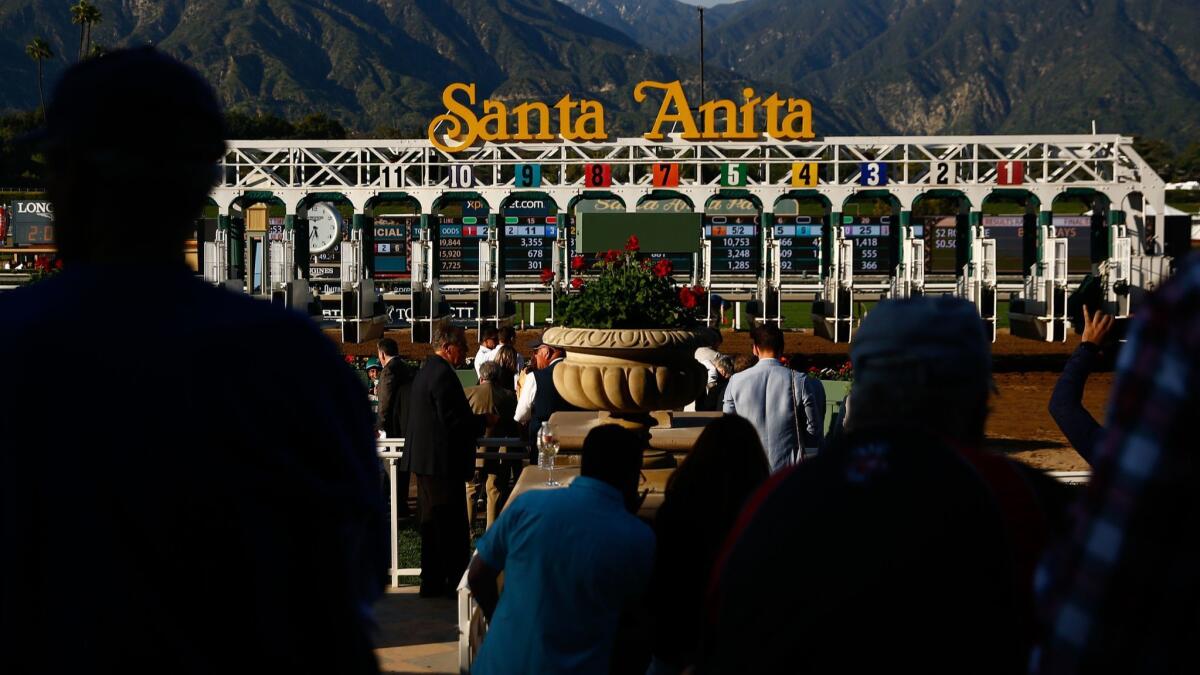Another horse dies at Santa Anita, the 25th since late December

- Share via
After six weeks of safe racing and training, Santa Anita had its second horse death in four days when a first-time starter pulled up during a race Sunday and was euthanized Monday. It was the 25th equine death at the Arcadia track since the start of the meet on Dec. 26.
Spectacular Music was running in a six-furlong maiden claiming race restricted to California-breds when jockey Jorge Velez pulled the horse up on the backstretch shortly after leaving the gate. The gelding was vanned off the course and taken to the barns with the hope of saving him after suffering a pelvis injury. However, the extent of the injury was such that it was decided on Monday morning to euthanize the horse.
The gelding was trained by Steve Miyadi and owned by Miyadi and breeder Nadine Anderson. He was offered up at the local Barretts sale in January 2018, received a bid of $900, but remained with Anderson.
On Friday, during training, Commander Coil was euthanized after suffering a shoulder-area injury. He was an unraced 3-year-old gelding and was just galloping, much less stressful and not considered risky. The gelding was trained by Marcelo Polanco and owned by Jose Romero. He was not bought at public auction.
The two injuries are similar only in that they are not the most common injuries. Most catastrophic injuries to horses occur in the fetlock or joint area of the leg, not the shoulder area or pelvis.
During the 2016-17 fiscal year, which is how the California Horse Racing Board collects statistics, seven of the 170 horse fatalities in the state were related to the pelvis and 10 related to the humerus, the bone between the shoulder and elbow. In 2017-18, of 113 fatalities in the state, four were in the humerus and five in the pelvis.
“You’ll find that there are pre-existing conditions on most scapular [shoulder blade], pelvic, lumbar [spine], humerus and tibia [lower leg] injuries,” said Dr. Rick Arthur, chief equine veterinarian of the CHRB. “But many are not clinically apparent. The problem is they are hard to discover because they are covered by muscle. Horses with these injuries don’t show lameness. They are very hard to pick up.”
Arthur did not know what prior treatment either of these two horses had received.
Sign up for our horse racing newsletter »
“The fetlock is our most worrisome structure,” Arthur said. “The other problem with some of the other bones is that they are not particularly repairable. Sometimes with the pelvis, you can do OK on repairing. Unfortunately, that wasn’t the case [with Spectacular Music].”
Santa Anita is well equipped to diagnose these types of injuries. The track has a nuclear scintigraphy machine that has examined more than 12,800 horses since it was installed at the track. Santa Anita also announced plans to add a Longmile Positron Emission Tomography Scan machine, called a MILE-PET, to its equine hospital. PET technology has been used on humans for a while, but not horses. The machine will aide in diagnosing fetlock injuries while the horse is standing.
The Stronach Group issued a statement that said, in part: “Before this catastrophic injury, unprecedented health and safety reforms were introduced at Santa Anita Park. From April 1 to May 18, there have been 698 starters on the main track and 651 starters on the turf course without fatalities. The Stronach Group is committed to advocating for the health and safety of horses and riders and will continue to work with stakeholders in California and nationally to drive further progress.”
Kathy Guillermo, senior vice president of PETA, called for more action.
“Two dead horses in three days proves that more must be done to end the training and veterinary practices that lead to broken bones,” Guillermo said. “… We urge the district attorney’s office to enlarge its investigation to include the trainers, owners, veterinarian and jockeys of Commander Coil and Spectacular Music. Santa Anita should suspend racing until stronger measures are enacted.”
The track was coming off a period in which it recorded almost 7,000 timed workouts and race starts without serious incident. The track estimates that around 80,000 horses had galloped during that period.
More to Read
Go beyond the scoreboard
Get the latest on L.A.'s teams in the daily Sports Report newsletter.
You may occasionally receive promotional content from the Los Angeles Times.











